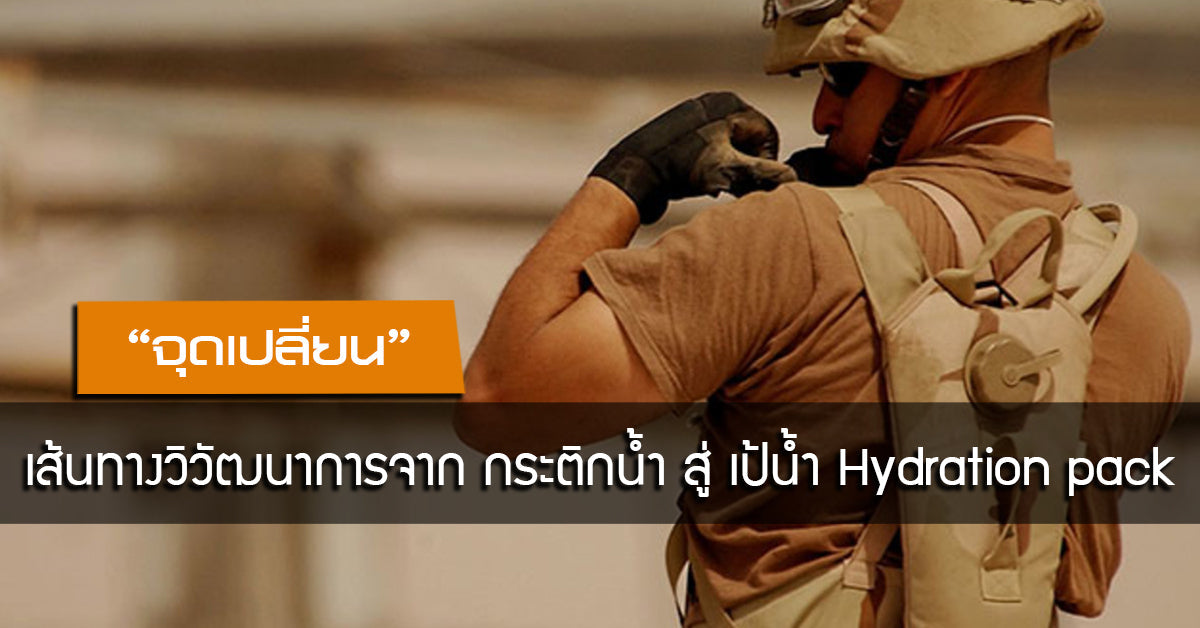In the past, soldiers either did not use subordinates to carry things or carried drinking water with water jugs.
Also known as Canteen in military circles.
During the Civil War in the era of American nation-building
Thermoses were made from a variety of materials that were discovered and processed at the time.
Whether it be from animal skin bags to tin cans, etc.

Water bag made from animal skin during the US Civil War, 1878.

It is usually carried or slung over the shoulder like a regular bag.A tin canteen from the United States Army during World War I, 1917.
Until the time of World War I, the metal thermos was developed, along with drinking glasses.
It is hung from the same belt that each soldier uses to string the ammunition pouches.
Until now, water bottles have been made of plastic, which is cheaper than metal.
But still maintains the shape of the bottle with curved cheeks to fit the waist and grip.
"Hydrate or Die"
The human body is made up of water, which makes up two-thirds of the total body composition.
Organs that contain water include:
Blood 92%
75% brain
75% muscle
Bone 22%
It can be seen that water is a necessary driving force for the human body to survive.
According to studies and calculations by the International Bottled Water Association
(International Bottled water Association)
The results concluded that a person weighing 90 kilograms
Exercise 60 minutes a day (approximately the equivalent of running 10 kilometers).
It is necessary to receive at least 4.2 liters of water to compensate.
In the training of new recruits in the US Army, soldiers are given the same old thermos.
And they are still trained to drink water from their own jugs.
However, the survey found that they were not drinking enough water.
Because of the clutter and hassle of drinking water
This has a negative impact on both training efficiency and the soldiers themselves.

Plastic water bottles distributed by the army
"Problems found with the current conventional water bottles"
What all the soldiers said in unison was water from a thermos.
It has an odd smell and taste like plastic.
Even though no one has ever tried eating plastic before
The best tasting and most refreshing drinking water
It is room temperature water rather than ice cold water.
Researchers revealed that water at a temperature of 45-55 degrees Celsius
It is the best temperature range for nutrient absorption.
and helps to cool down the body temperature well.
Traditional water bottles are cumbersome and a burden to carry and use.
With the weight of a full bottle of water, put it in a water bottle pocket and attach it to your belt.
That every soldier must carry his own reserve ammunition with him.
It becomes a burden that reduces the efficiency and speed of the workforce.

Load Bearing Equipment shoulder strap with 2 water bottles
According to the field uniform regulations
This does not include having to crouch, crawl or climb, which becomes more difficult when
There is a weight of the flask swinging loosely around the waist, and the flask itself also has
Chance of getting entangled in vines, branches or barbed wire when moving through obstacles.
To drink water from a flask, soldiers had to waste time undoing the flap.
Pull the bottle up, twist the cap, drink, twist the cap off, put the bottle in your pocket and close the pocket to prevent it from falling out.
And in tactical terms, the sound of splashing water inside an incompletely filled jug
It is also a major obstacle to location camouflage.
"It's time to find something better."

The T3 Hans Backpack is a water bag and other equipment, including a ballistic helmet.
The International Bottled Water Association published a newspaper article in 1999.
Define water as “brain food,” “diet food,” “nutritious fluid.”
And "Bodyguard of the Body"
Seeing that "water" is important to the body, the next idea is to combine
Equipment that can hold enough water and must always be carried by the personnel.
Something that is not an old fashioned thermos
The sling is hung on a belt, and the weight is reduced with shoulder straps.
And importantly, the usage must not be too complicated. Create habits for the personnel to be able to do so.
Keep sipping or drinking water regularly without making it too much of a hassle for soldiers to drink water.
"The origin of this solution"
Over 20 years ago, a former rescue worker applied to join
A bicycle race that is a long distance and takes a whole day.
In Wichita Falls, Texas
He considered that a long-distance race of this size required
A quantity of water greater than the water bottle attached to the bicycle frame.
And to make time in the race, stopping to refill the water bottle takes too much time.
Or picking up a thermos to drink while cycling may be dangerous.
From problems to solutions
He tried using an IV bag connected to a tube.
Sew socks onto the back of his cycling jersey.
And put the saline bag in the sock on the back and attach the tube over the front shoulder.
This innovative idea is the origin of today's water bags.
Water bags nowadays come in a variety of capacities.
From 1-3 liters, which is a weight that is not a burden.
and sufficient for a mission not exceeding 12 hours.

Overall, from many manufacturers, water bags will consist of:
The 4 parts are:
1. Insulated outer bag (Hydratioin pack)
2. Hydration Bladder
3. Insulated rubber hose to keep temperature
4. End of the hose for drinking water
The outer bag also has a variety of appearances and uses to choose from.
Especially in an era where MOLLE has replaced the ALICE system, a water bag may not be the case.
Just a bag with a shoulder strap like a backpack.
But it can also be attached to the armor shell with MOLLE.
Most are insulated to maintain the water temperature.
Where conditions may change rapidly depending on the weather conditions of the operating area.
The water bag is made of high quality plastic that does not tear, leak or give off a plastic taste.
The water container is a flat bag with a screw cap for adding water.
and the lid's mouth is large enough to put ice on top
Flat sheets according to bag size or packing volume
The bottom of the bag is connected to a tube in the same way as an IV bag.
That uses the pressure and gravity of the earth to make water flow easily.
The rubber tube connected under the bottom of the bag is rolled up and protrudes in the position
Close to the bag strap or back of the neck when worn.
To be worn over the shoulder or attached to a bag strap.
Until it reaches the user's mouth, where they just have to tilt their neck.
Or grab it and drink it like you would a straw from a glass.
It is also insulated to maintain temperature, just like the outer bag.

The end of the cable is a small plastic or rubber joint that fits in one bite.
There is a cover to protect from dust or dirt.
It can be used for both drinking and refilling water through the end of the tube.
In the present era, it has been developed to be closer in size.
Side by side for use with personal water filters
If the situation is unavoidable, natural water sources
Where there may be dirt or toxic substances to the body
It is recorded that the use of water bags began during the Panama mission.
Corporal Andrew Laskoski commented:
"The cool thing about it is that you can sip water while fighting your enemies."
Pathways of water consumption change
The personnel's stuff is a long time ago until the point of the water bag system.
It allows soldiers to carry drinking water without any bulk and maintains the right temperature.
Able to move nimbly and can drink water regularly.
Without even taking your hands off your weapon.
To maintain the body's potential and be ready at all times

Source: https://alu.army.mil/alog/issues/JulAug00/MS498.htm
Article: Alternatives to the Soldier Canteen
Translated by: Thithat Rinchai on January 17, 2021


